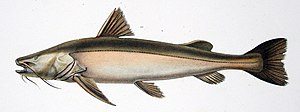Zungarowels
| Zungarowels | ||||||||||||
|---|---|---|---|---|---|---|---|---|---|---|---|---|

Zungaro zungaro , drawing by Castelnau |
||||||||||||
| Systematics | ||||||||||||
|
||||||||||||
| Scientific name of the genus | ||||||||||||
| Zungaro | ||||||||||||
| Bleeker , 1858 | ||||||||||||
| Scientific name of the species | ||||||||||||
| Zungaro zungaro | ||||||||||||
| ( Humboldt , 1821) |
The Zungarowels ( Zungaro zungaro ) is a South American giant catfish from the family of the aerial catfish , which occurs in the great streams and rivers.
description
The catfish described by Anglo-Saxon authors as Giant Jelly Catfish or Gilded Catfish is called Jaú in Brazil and Manguruyú in Argentina . The species Paulicea luetkeni described by Franz Steindachner in 1877 is identical to the Zungarowels. The taxon Brachyplatystoma flavicans is also synonymous . There are three subspecies: Zungaro z. jahu or Zungaro z. mangurus and the nominate form Zungaro z. zungaro .
The Zungarowels can weigh 50 kilograms. The current IGFA world record is 49.44 kg, this specimen was caught in the Rio Urariquera, in the state of Roraima in Brazil. However, weights of up to 150 kilograms and a length of 1.5 meters have already become known. Alleged lengths of over two meters are not confirmed. It is characterized by a broad, flattened head. Its mouth is equipped with sharp teeth. The adipose fin is small. The adult fish are coffee brown, the juvenile fish grayish yellow with dark spots in the shape of a U or C on the back or on the adipose fin.
distribution
Tungaro catfish have their main distribution area in the northern and central-western Amazon region in Brazil , Peru and Bolivia , in the catchment area of the Araguaia-Tocantins and the Rio São Francisco in eastern Brazil. In Colombia one finds local populations of them in the Río Magdalena , in the Orinoco in Venezuela also in the Río Paraguay , Río Iguazú , Río Paraná and Río de la Plata in Argentina . It is partially introduced in São Paulo , Minas Gerais and Paraná .
Way of life
The Zungarowels is a nocturnal catfish that occurs in deep waters and upstream of large currents in the muddy bottom. It is often found in the main stream of the river in deep, washed-out places, depressions below rapids and waterfalls. During the dry season it follows the feeder fish, mainly Prochilodus lineatus, which it also follows upstream on the way to their spawning grounds. During the rainy season, Tungaro catfish also penetrate far into the flood plains. It feeds mainly on fish and other small animals. The Jaú develops a pronounced hiking behavior on the Rio de la Plata. Catfish were also marked in the Rio Grande / Minas Gerais , which were later caught in the 8 to 20 meter deep river bed in the Funil reservoir. The spawning maturity is reached from a weight of approx. 10 kilograms and a length of approx. 70 centimeters, the ovaries of the Rogner can contain over three million eggs. The Zungarowels prefer to spawn in the estuary of large rivers. In the Rio Paraná, Zungarowels spawn from December to February.
use
As a sport fish, it has a certain importance. Because of its meat consistency, it is not very valued as a food fish in Amazonia , but it is more important in southeastern Brazil. The stocks in the Rio Paraná and Rio Paraguay are already seriously threatened by overfishing . In their original southern distribution area, they have already disappeared in natural waters in many places.
Web links
- Zungarowels on Fishbase.org (English)
- Manguruyú "El coloso que esta volviendo" ( Memento of October 9, 2007 in the Internet Archive ) (Spanish)
Individual evidence
- ↑ http://silurus.acnatsci.org/ACSI/library/biblios/2007_Ferraris_Catfish_Checklist.pdf
- ↑ https://www.itis.gov/servlet/SingleRpt/SingleRpt?search_topic=TSN&search_value=681805
- ↑ Archive link ( Memento of the original from November 1, 2010 in the Internet Archive ) Info: The archive link has been inserted automatically and has not yet been checked. Please check the original and archive link according to the instructions and then remove this notice.
- ↑ a b c Zungarowels on Fishbase.org (English)
- ↑ http://www.scielo.br/scielo.php?script=sci_arttext&pid=S1679-62252007000200018